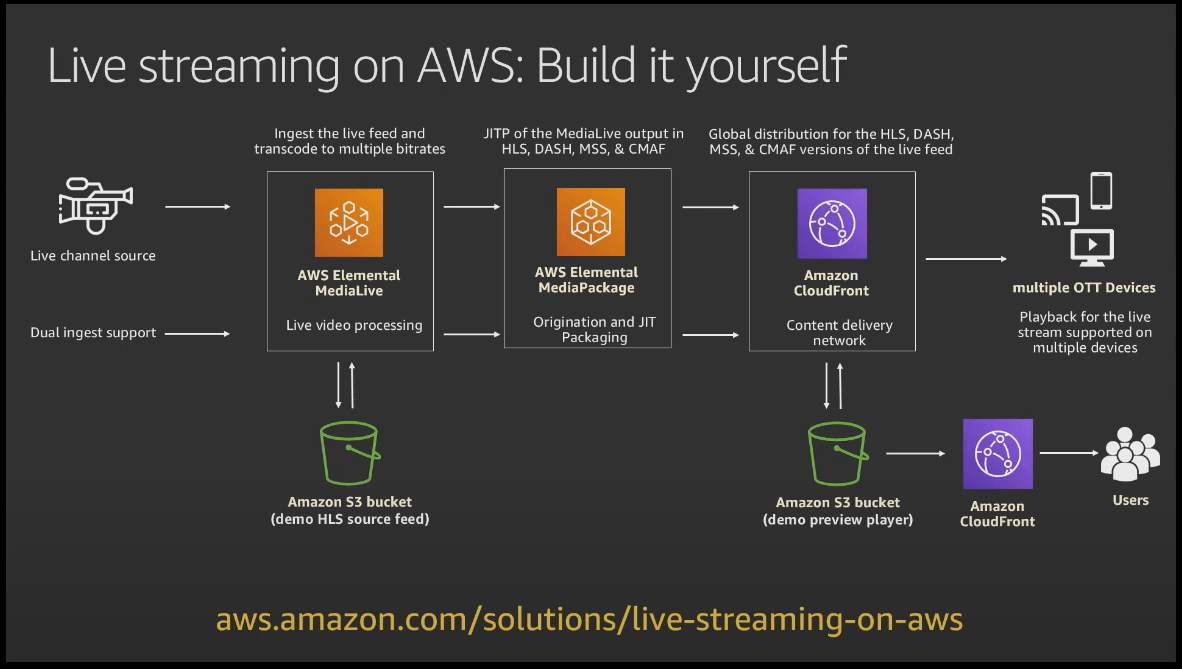Scaling and Live Streaming on AWS for Millions of Users
 Karan Mhaske
Karan Mhaske
When I first started diving into the world of cloud computing, I was drawn to the idea of building scalable systems—specifically, ones that could handle real-time demands, like live streaming. I still remember the excitement (and maybe a little fear) when I decided to take on a project focused on building a live streaming architecture on AWS. The goal? To design a solution capable of supporting millions of users, all watching the same event at the same time.
Sounds simple, right? Well, not exactly.
The Challenge of Live Streaming at Scale
The idea of live streaming is nothing new, but it’s become the backbone of many industries—from entertainment to education and even virtual events. So, getting it right is crucial. But here’s the thing: when you’re dealing with a few thousand users, a simple setup might suffice. When you’re dealing with millions, everything changes.
In this project, my task was to design an infrastructure that could:
Ingest live video from multiple sources.
Encode and transcode the video in real-time for different devices and connection speeds.
Distribute it globally with minimal latency.
It sounded straightforward on paper, but in reality, the complexity was hidden in the details.
Building with AWS: Tools of the Trade
One of the first things I learned was the sheer power of AWS’s suite of services tailored for media and entertainment. AWS Elemental MediaLive and MediaPackage became my best friends during this project.
AWS Elemental MediaLive: This service handled live video processing and encoding. It allowed me to convert a single input stream into multiple output streams, each tailored for different devices. Whether the user was watching on a smartphone with a spotty connection or a high-definition TV, MediaLive made sure they got the best possible experience.
AWS Elemental MediaPackage: Here’s where things got really interesting. MediaPackage took the streams from MediaLive and packaged them in formats like HLS, DASH, and CMAF, which are the standard for video streaming across different devices. It also supported just-in-time packaging, meaning it could deliver the right format exactly when it was needed, without pre-packaging everything upfront.
Amazon CloudFront: The final piece of the puzzle was CloudFront, AWS’s content delivery network (CDN). It made sure that no matter where the viewer was located, the video content would be delivered quickly and reliably. This was essential for reducing latency and ensuring that the live stream didn’t buffer or lag during peak moments.
Lessons Learned Along the Way
Now, I’m not going to lie—there were plenty of challenges along the way. For one, dealing with spikes in traffic during live events was a real eye-opener. It’s easy to assume that everything will just “scale” on the cloud, but the reality is a bit more nuanced.
One major takeaway was the importance of monitoring and automation. AWS offers incredible tools like CloudWatch and Auto Scaling, which helped me adjust resources dynamically based on traffic patterns. For example, during a live sports event, traffic would spike at the start, during key moments, and near the end. Having an automated system that could scale up and down as needed was a lifesaver.
I also learned that designing for failure is just as important as designing for success. AWS’s architecture allows for redundancy, and by leveraging multiple Availability Zones and Regions, I was able to ensure that even if something went wrong in one part of the world, the stream would continue uninterrupted.
Personal Growth Through Cloud Challenges
More than anything, this project was a lesson in perseverance. There were late nights where things just didn’t work as expected—whether it was a video not encoding properly or latency issues that seemed to appear out of nowhere. But pushing through those challenges taught me the value of patience and problem-solving.
One of the most rewarding aspects was seeing the final result: a live stream that could handle millions of users simultaneously without a hitch. It was a proud moment, knowing that I had built something robust enough to support such high demands.
Moving Forward: What’s Next?
This experience left me hungry for more. Live streaming is just one of the many ways cloud technology is shaping the future, and I’m excited to explore even more advanced applications. Whether it’s scaling other types of media, building smarter infrastructures, or diving deeper into AI and machine learning, the sky’s the limit.
For now, though, I’m just happy to have completed this project and gained invaluable insights into the world of cloud computing and live streaming at scale.
If you’re working on similar projects or have tackled the challenge of scaling for millions of users, I’d love to hear your thoughts! Let’s connect and share our experiences as we continue to push the boundaries of what’s possible with cloud technology.
Subscribe to my newsletter
Read articles from Karan Mhaske directly inside your inbox. Subscribe to the newsletter, and don't miss out.
Written by

Karan Mhaske
Karan Mhaske
"I am an undergraduate student with a strong passion for technology and innovation. Currently, I'm working in the DevOps domain at Kloud Kampus, where I specialize in cloud computing and DevOps practices. My focus and expertise lie in creating efficient and scalable solutions in this field." Beyond my technical skills, I possess a strong entrepreneurial mindset and a passion for innovation. I enjoy exploring, understanding how Al can revolutionize various industries. As an aspiring professional, I am eager to work on challenging projects and collaborate with like-minded individuals. I am open to internships, research positions, and industry opportunities that align with my interests.